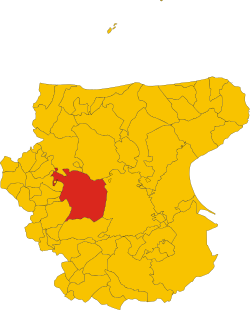Lucera
| Lucera | |
|---|---|
| Comune | |
 Location of Lucera in the province of Foggia |
|
| Location of Lucera in Italy | |
| Coordinates: 41°30′N 15°20′E / 41.500°N 15.333°E | |
| Country | Italy |
| Region |
|
| Province / Metropolitan city | Foggia (FG) |
| Government | |
| • Mayor | Antonio Tutolo (coalition of municipal lists) |
| Elevation | 50 m (160 ft) |
| Population (June 2012) | |
| • Total | 34,243 |
| Demonym(s) | Lucerini |
| Time zone | CET (UTC+1) |
| • Summer (DST) | CEST (UTC+2) |
| Postal code | 71036 |
| Dialing code | 0881 |
| Patron saint | St Mary |
| Saint day | 16 August |
| Website | Official website |
Lucera is an Italian city of 34,243 inhabitants in the province of Foggia in the region of Apulia, and the seat of the Diocese of Lucera-Troia.
Situated at the confluence of the valleys of Molise and Campania in the Tavoliere delle Puglie, Lucera was the capital of Capitanata and of the County of Molise from 1579 until 1806.
The city is characterized by a Mediterranean climate, with long, hot summers, with extreme temperature changes during the day, and mild winters, although due to its proximity to the Daunian mountains the temperature can drop to values below 0 °C (32 °F). The winds are quite frequent and, although sometimes quite strong, are usually moderate.
The average annual temperature is around 15 °C (59 °F), and rainfall amounts to an average value of 497 millimetres (19.6 in). Snowfalls are rare.
Lucera is located in the territory of the Dauni ancient tribe. Archeological excavations show the presence of a bronze age village inside the city boundaries. Lucera was probably named after either Lucius, a mythical Dauno king, or a temple dedicated to the goddess Lux Cereris. A third possibility is that the city was founded and named by the Etruscans, in which case the name probably means Holy Wood (luc = "wood", eri = "holy").
In 321 BC, the Roman army was deceived into thinking Lucera was under siege by the Samnites. Hurrying to relieve their allies the army walked into an ambush and were defeated at the famous Battle of the Caudine Forks. The Samnites occupied Lucera but were thrown out after a revolt. The city sought Roman protection and in 320 BC was granted the status of Colonia Togata, which meant it was ruled by the Roman Senate. In order to strengthen the ties between the two cities, 2,500 Romans moved to Lucera. From then on, Lucera was known as a steadfast supporter of Rome.
During the civil wars of the late Republic, Pompey set up his headquarters in Lucera, but abandoned the city when Julius Caesar approached. Lucera quickly switched its allegiance and Caesar's clemency spared it from harm. In the next civil war between Octavian and Mark Anthony the city did not escape as lightly. After the war, Octavian settled many veteran soldiers on the lands of the ruined city. This helped Lucera recover quickly and marked an era of renewed prosperity. Many of the surviving Roman landmarks hail from this Augustan period, among them the Luceran amphitheatre.
...
Wikipedia

